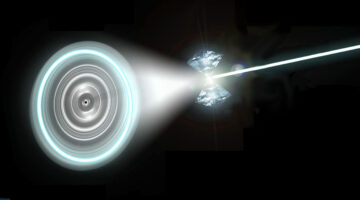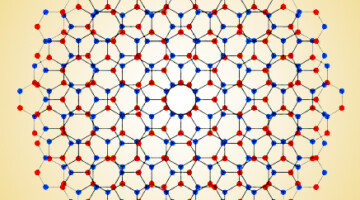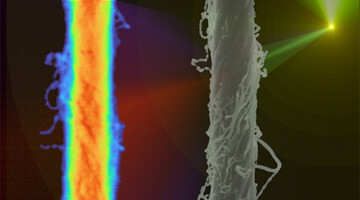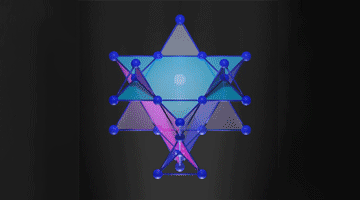In the superhard material, rhenium diboride, smaller grain size leads to greater yield strength (i.e., the amount of stress tolerated before permanent deformation). Because such transition-metal borides are extremely hard, metallic, and can be synthesized at ambient pressure, they have exciting potential for use in next-generation cutting tools. Read more »![]()
![]()
A Novel Staircase Pattern in Spin-Stripe Periodicity
Striped patterns of spins in a magnetic thin film were found to evolve under an applied magnetic field in steps reminiscent of a structure known as the “Devil’s Staircase.” Such studies are valuable for understanding competing interactions at the atomic level for applications such as magnetic sensors and spintronic devices. Read more »![]()
![]()
Direct Observation of Room-Temperature Magnetic Skyrmion Motion Driven by Ultra-Low Current Density in Van Der Waals Ferromagnets
Researchers demonstrate current-driven magnetic skyrmion motion in van der Waals ferromagnets at room temperature. The skyrmion motion presents ultra-low critical current density to activate their dynamics, thanks to minimized defects in the van der Waals gap. The findings will provide a new platform for spintronics application in the future. Read more »
Surprise Mineral Precursor Found in Coral Skeletons and Mollusk Shells
Researchers studied samples from corals, mollusks, and sea urchins, at edges where mineral precursors start to form the new shell or skeleton. There, they found a surprise: corals and mollusks produced a mineral precursor that had never been observed before in living organisms or rocks, and had only recently been created synthetically. Read more »
Aluminothermic reduction of CeO2: Mechanism of an economical route to aluminum–cerium alloys
In this study, we demonstrate a novel approach to producing Al–Ce alloys by reducing CeO2 in liquid aluminum at 95% reduction efficiency. This work provides the basis of an economic route to producing high-strength Al–Ce alloys with enhanced dispersion strengthening from embedded Al2O3 particles. Read more »
Shedding Light on Sea Creatures’ Secrets
Exactly how does coral make its skeleton, a sea urchin grow a spine, or an abalone form the mother-of-pearl in its shell? A new study at the ALS revealed that this process of biomineralization, which sea creatures use to lock carbon away in their bodies, is more complex and diverse than previously thought. Read more »
Room-Temperature 2D Magnet: Electronic-Structure Insights
Researchers found that small changes in how electron spins interact with each other can make a big difference in the magnetic transition temperatures of 2D magnets. Understanding such factors can help create better magnetic materials for information storage, sensors, medical imaging, and energy-efficient computing. Read more »![]()
![]()
Big Twist Leads to Tunable Energy Gaps in a Bilayer Stack
Researchers found that twisting 2D layers at atypically large angles opens up potentially useful energy gaps in the material’s band structure. The results suggest a new way to tune materials for optoelectronic applications and provide a platform for exploring novel “moiré” phenomena beyond those observed at small twist angles. Read more »![]()
![]()
How Processing Affects Structure in Composite Nanotube Yarns
Using the ALS, researchers found quantitative correlations between processing parameters and the structure of ultrafine, polymer-reinforced carbon-nanotube fibers. The work will facilitate the production of high-strength materials, including those needed for positioning target capsules for fusion research at the National Ignition Facility. Read more »![]()
![]()
Flat Bands Signal Electrons Trapped in 3D
Researchers found flat electronic band structures—known hallmarks of electrons trapped in two dimensions—but in a material that extends this phenomenon to three dimensions. The work opens up a material framework for exploring superconductivity and other exotic states in three dimensions for advanced electronic applications. Read more »![]()
![]()
- 1
- 2
- 3
- …
- 24
- Next Page »









